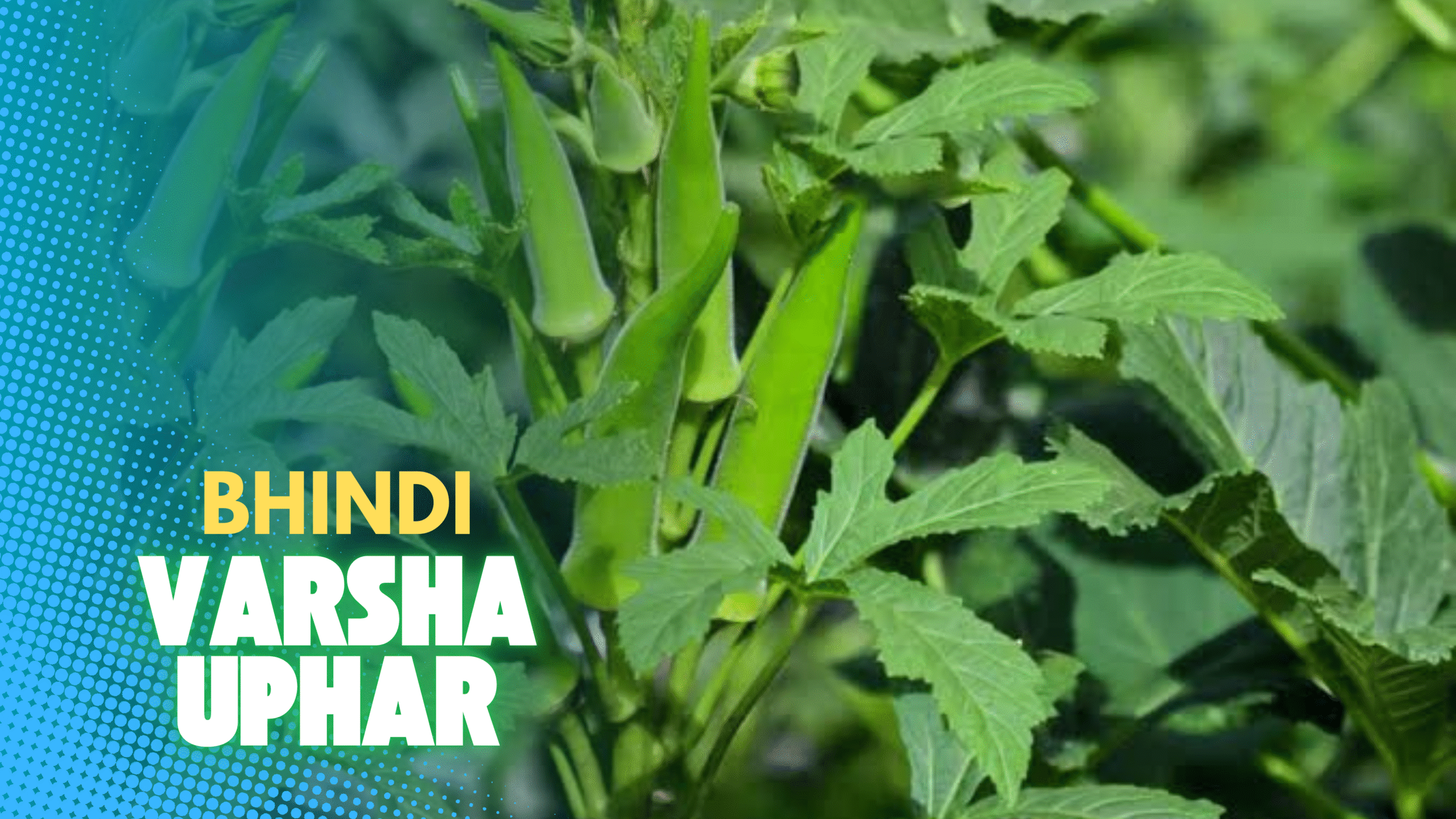Bhindi, also known as okra or lady’s finger (Abelmoschus esculentus L. Moench), is a staple vegetable in tropical and subtropical regions, cherished for its tender, nutritious pods used in a variety of culinary dishes. Among the numerous varieties of bhindi cultivated worldwide, Varsha Uphar stands out as a notable variety due to its resilience to diseases, adaptability to specific climatic conditions, and impressive yield potential. This article provides an in-depth exploration of the Varsha Uphar bhindi variety, covering its origin, characteristics, cultivation practices, disease resistance, and performance based on available research and agricultural insights.
Origin and Development
Varsha Uphar is a hybrid bhindi variety developed through pedigree selection from a cross between Lam Selection 1 and Parbhani Kranti, two well-known okra varieties with desirable traits. This hybridization effort was aimed at combining the disease resistance and yield potential of its parent lines to create a variety suitable for diverse agro-climatic conditions, particularly in India. The variety was developed as part of efforts to address the challenges posed by the Yellow Vein Mosaic Virus (YVMV), a devastating disease affecting okra crops. Varsha Uphar has been recognized by agricultural institutions such as the Tamil Nadu Agricultural University (TNAU) and is listed among recommended varieties for cultivation due to its robust traits.
Botanical and Agronomic Characteristics
Plant Morphology
- Height: Varsha Uphar plants typically grow to a height of 90–120 cm, making them moderately tall and suitable for dense planting arrangements.
- Branching: The plants produce 2–3 branches per node, which contributes to higher fruiting potential. The internodal distance is relatively short, allowing for compact growth.
- Leaves: The leaves are dark green, broad, and lobed, with a healthy leaf area index (LAI) of approximately 1.42 under optimal conditions, indicating good photosynthetic capacity.
- Flowers: Flowering begins around 40 days after sowing during the monsoon season, with flowers that are typical of the Malvaceae family—white to yellow with a purple center.
Fruit Characteristics
- Color and Shape: The pods of Varsha Uphar are dark green, slender, and have five ridges, which is a desirable trait for marketability.
- Size: Fruits measure approximately 15–18 cm in length with a girth of about 7.22 cm and an average fruit weight of 20.8 g.
- Yield: Under optimal conditions, Varsha Uphar can yield up to 20.78 tons per hectare, making it a high-yielding variety compared to many traditional cultivars.
Growth and Maturity
Varsha Uphar is well-suited for the monsoon season (kharif) but can also perform well in summer with proper management. The variety reaches fruiting stage within 46–50 days after sowing, making it a relatively early-maturing variety ideal for farmers seeking quick returns.
Disease Resistance
One of the standout features of Varsha Uphar is its resistance to Yellow Vein Mosaic Virus (YVMV), a major constraint in okra cultivation. YVMV, transmitted by the whitefly (Bemisia tabaci), causes characteristic vein clearing and can lead to yield losses of up to 100% if uncontrolled. While some studies indicate that Varsha Uphar may show susceptibility during the kharif season under high disease pressure, it generally performs better than many other varieties, such as Pusa Sawani, which is highly susceptible. The variety’s resistance is attributed to its genetic lineage, particularly from Parbhani Kranti, which is known for YVMV tolerance.
To manage YVMV effectively with Varsha Uphar:
- Weed Control: Remove weeds that serve as alternate hosts for the virus.
- Whitefly Management: Use integrated pest management (IPM) practices, such as yellow sticky traps and neem-based insecticides, to control whitefly populations.
- Sowing Time Adjustment: Planting during periods of lower whitefly activity can reduce disease incidence.
Climatic and Soil Requirements
Varsha Uphar thrives in tropical and subtropical climates, with optimal temperatures ranging from 24°C to 28°C for growth and development. It is particularly suited for the monsoon season but can be cultivated year-round in regions with moderate climates, such as South India. The variety is sensitive to frost and does not germinate well below 20°C. High temperatures above 40–42°C may cause flower drop, leading to yield losses.
Soil Preferences
- Type: Varsha Uphar grows best in well-drained loamy soils with a pH range of 6.0–7.5.
- Nutrient Requirements: The variety responds well to organic and inorganic fertilizers. Studies have shown that the application of 50% nitrogen as farmyard manure (FYM) combined with foliar application of 5% non-herbal Kunapajala (a fermented liquid organic manure) significantly enhances plant height, branching, and yield.
Cultivation Practices
Sowing and Spacing
- Sowing Time: For monsoon cultivation, sowing is recommended between June and July. For summer crops, February is ideal for early planting to maximize market prices.
- Seed Rate: Approximately 8–10 kg of seeds per hectare is required.
- Spacing: A spacing of 60 cm x 30 cm is recommended to ensure adequate light and air circulation, promoting healthy plant growth.
Nutrient Management
Varsha Uphar responds exceptionally well to organic manures, particularly Kunapajala and Panchagavya, which enhance growth parameters such as plant height, number of branches, and fruit yield. A field experiment conducted in 2020 demonstrated that foliar application of 5% non-herbal Kunapajala resulted in:
Inorganic fertilizers like NPK (nitrogen, phosphorus, potassium) can also be used, but integrating organic manures with chemical fertilizers (e.g., INM: Integrated Nutrient Management) has been shown to improve both growth and yield while maintaining soil health.
Irrigation
Varsha Uphar requires consistent moisture, especially during flowering and fruiting stages. Drip irrigation or furrow irrigation every 4–5 days during dry periods ensures optimal pod development. Overwatering should be avoided to prevent root rot.
Pest and Disease Management
Apart from YVMV, Varsha Uphar may be susceptible to pests like fruit borers and aphids. Regular monitoring and the use of biopesticides, such as neem oil, can help manage pest populations. For diseases like Cercospora leaf spot, maintaining low humidity through proper spacing and avoiding overhead irrigation is recommended.
Yield and Economic Benefits
Varsha Uphar’s high yield potential (up to 20.78 t/ha) makes it an economically viable choice for farmers. The variety’s early maturity (fruits ready for harvest within 46–50 days) allows farmers to capitalize on early market prices, especially during the off-season. Its dark green, slender pods are highly marketable, appealing to both domestic and export markets. Additionally, the variety’s resistance to YVMV reduces the need for chemical interventions, lowering input costs and making it suitable for organic farming systems.
Research Insights
Several studies have highlighted the performance of Varsha Uphar under different management practices:
- Organic Manure Studies: Research conducted by Kavya and Ushakumari (2020) found that Varsha Uphar exhibited superior growth and yield when treated with 50% FYM + 5% non-herbal Kunapajala, attributing the success to the availability of nutrients, microorganisms, enzymes, and growth hormones in the manure.
- Disease Resistance Trials: A 2013 study at Birsa Agricultural University noted that Varsha Uphar was susceptible to YVMV during kharif but performed better in summer, suggesting that environmental factors and disease pressure influence its resistance.
- Nutrient Uptake: Field experiments have shown that Varsha Uphar exhibits efficient uptake of nitrogen, phosphorus, potassium, and micronutrients when grown with organic manures like FYM, outperforming chemical fertilizers in some cases.
Market Availability and Seeds
Seeds of Varsha Uphar are widely available through agricultural suppliers and online platforms like Amazon, where they are marketed for home and commercial cultivation. The variety is particularly recommended for rainy season planting due to its adaptability to humid conditions.
Culinary and Nutritional Value
Bhindi, including Varsha Uphar, is a nutritious vegetable rich in vitamins A and B, protein, minerals, and iodine, making it valuable for preventing goiter and supporting overall health. The pods are used in a variety of dishes, such as stir-fries, curries, and soups, and can be dried or frozen for off-season use. The variety’s tender, dark green pods are particularly favored for their texture and flavor.
Conclusion
Varsha Uphar is a versatile and high-performing bhindi variety that combines disease resistance, early maturity, and excellent yield potential. Its adaptability to monsoon conditions, coupled with its responsiveness to organic manures, makes it an ideal choice for both conventional and organic farmers. While it may show some susceptibility to YVMV under high disease pressure, proper management practices can mitigate this issue, ensuring consistent yields. For farmers and home gardeners looking for a reliable, high-yielding, and market-friendly bhindi variety, Varsha Uphar is an excellent option.
By leveraging its agronomic strengths and following recommended cultivation practices, Varsha Uphar can contribute significantly to sustainable agriculture and food security in tropical and subtropical regions. Its continued popularity among farmers underscores its value as a resilient and productive crop in the face of climatic and disease challenges.

